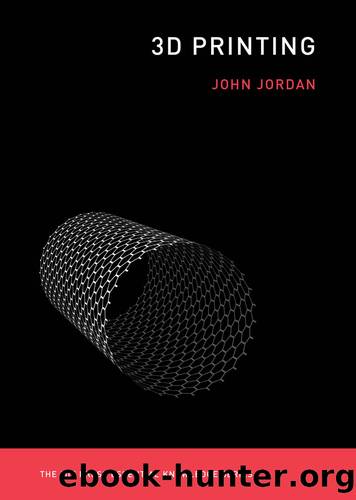3D Printing by John Jordan

Author:John Jordan [Jordan, John]
Language: eng
Format: epub
Tags: Additive manufacturing; 3D printing; digital fabrication; CAD; generative design; metal; polymer; fused deposition modelling; GE; CNC; mass customization; fab lab; artificial organs
Publisher: MIT Press
Published: 2019-02-08T00:00:00+00:00
Figure 5.1 GE LEAP fuel nozzle (image courtesy of GE)
In 2014 Ehteshami shared his findings with his superior, the head of GE Aviation, who then told the CEO and the board. As a result, 3D printing soon became a core GE competency. Additive technology research and development centers were launched in Cincinnati, Dayton, Pittsburgh, and elsewhere. More acquisitions were completed: in 2016 GE bought 75 percent of Arcam, the Swedish manufacturer of metal 3D printers using electron beams, and 75 percent of the German firm Concept Laser, which pioneered powder bed selective laser melting. GE opened a 3D printing factory for the LEAP nozzles in Auburn, Alabama. The first pair of more than 12,000 engines ordered was delivered and put into service in 2016. In Italy, meanwhile, a GE additive facility is printing turbine blades out of a titanium alloy for the GE9X, a jet engine used on the Boeing 777.
GEs engineers also worked to apply additive techniques to a new engine, this one a turboprop. This time the team consolidated 855 individual parts into twelve 3D printed assemblies. Once again, the advantages included reduced weight, 20 percent better fuel efficiency, and 10 percent more power output. In addition, development time was a third faster using additive techniques for rapid prototyping. In 2016, GEâs engine design was chosen by Textron Aviation for its initial run of Cessna Denalis.
Several aspects of the GE story are worth underlining. First, 3D printing can change performance criteria by significant margins: fuel savings, power, development time, cost, and durability all saw major improvements. Second, rather than being expensive or impossible, complexity gets inexpensive: in some sense, the bigger limit is the designerâs imagination and tools rather than the capability of the fabrication technology. Third, conventional manufacturing financial metrics had to be managed, in this case through stealth, as GE engineers climbed the learning curve. Finally, complex fuel nozzles proved the benefits of additive manufacturing on a part that isnât particularly mechanically strong or stressed. Parts subject to physical load (wheel struts, flight control surfaces, door hinges) are still problematic in that the long-term stress and failure points of 3D printed parts are not fully understood.
Additive manufacturing appears to have two primary industrial uses along with three secondary ones. As we have just seen, the first relates to complex geometries. In the second, it is worth considering the textbook definition of economies of scale (see figure 5.2).
In conventional mass production, investments in tooling, raw materials inventories, and labor skills do not pay back instantly. Once the organization has learned how to make an item and has a reasonably well known demand for it, however, it can be produced for some duration in large numbers at a low cost. Late in the life cycle, demand will slow, increasing carrying costs. Machines break, people retire or quit, and new priorities compete for production equipment, investment, and labor. Late in the productâs life, it often becomes more expensive to produce as obsolescence also becomes a factor.
Various studies have identified the break-even point where long-run mass production begins to exhibit a cost advantage.
Download
This site does not store any files on its server. We only index and link to content provided by other sites. Please contact the content providers to delete copyright contents if any and email us, we'll remove relevant links or contents immediately.
| Body Art & Tattoo | Calligraphy |
| Ceramics | Conceptual |
| Digital | Erotic |
| Film & Video | Glass |
| Graffiti & Street Art | Illuminations |
| Installations | Mixed Media |
| Mosaic | Prints |
| Public Art | Video Games |
Kathy Andrews Collection by Kathy Andrews(10551)
Thirteen Reasons Why by Jay Asher(7801)
The Red Files by Lee Winter(2923)
How to Do Nothing by Jenny Odell(2651)
The Genius of Japanese Carpentry by Azby Brown(2615)
Stacked Decks by The Rotenberg Collection(2283)
Tattoo Art by Doralba Picerno(2086)
Champions of Illusion by Susana Martinez-Conde & Stephen Macknik(2079)
The Art of Doom by Bethesda(1777)
The Artist's Way Workbook by Cameron Julia(1736)
Calligraphy For Dummies by Jim Bennett(1645)
Creative Character Design by Bryan Tillman(1562)
Botanical Line Drawing by Peggy Dean(1534)
One Drawing A Day by Veronica Lawlor(1497)
Wall and Piece by Banksy(1463)
The Art of Creative Watercolor by Danielle Donaldson(1455)
Art Of Atari by Tim Lapetino(1329)
Happy Hand Lettering by Jen Wagner(1325)
Artificial Intelligence for Games by Ian Millington & John Funge(1304)
